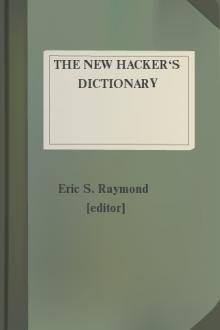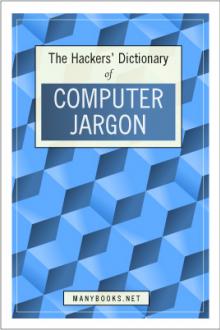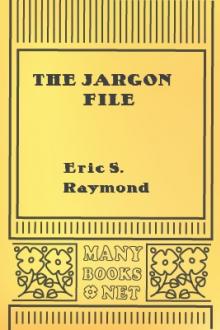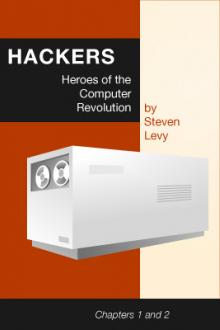The New Hacker's Dictionary by Eric S. Raymond (romantic novels to read .txt) 📕

- Author: Eric S. Raymond
- Performer: 0262680920
Book online «The New Hacker's Dictionary by Eric S. Raymond (romantic novels to read .txt) 📕». Author Eric S. Raymond
Up:[4148]= D =
DoS attack //
[Usenet,common; note that it's unrelated to `DOS' as name of an
operating system] Abbreviation for Denial-Of-Service attack. This
abbreviation is most often used of attempts to shut down newsgroups
with floods of [4149]spam, or to flood network links with large
amounts of traffic, or to flood network links with large amounts of
traffic, often by abusing network broadcast addresses Compare
[4150]slashdot effect.
Node:dot file, Next:[4151]double bucky, Previous:[4152]DoS attack,
Up:[4153]= D =
dot file [Unix] n.
A file that is not visible by default to normal directory-browsing
tools (on Unix, files named with a leading dot are, by convention, not
normally presented in directory listings). Many programs define one or
more dot files in which startup or configuration information may be
optionally recorded; a user can customize the program's behavior by
creating the appropriate file in the current or home directory.
(Therefore, dot files tend to [4154]creep -- with every nontrivial
application program defining at least one, a user's home directory can
be filled with scores of dot files, of course without the user's
really being aware of it.) See also [4155]profile (sense 1), [4156]rc
file.
Node:double bucky, Next:[4157]doubled sig, Previous:[4158]dot file,
Up:[4159]= D =
double bucky adj.
Using both the CTRL and META keys. "The command to burn all LEDs is
double bucky F."
This term originated on the Stanford extended-ASCII keyboard, and was
later taken up by users of the [4160]space-cadet keyboard at MIT. A
typical MIT comment was that the Stanford [4161]bucky bits (control
and meta shifting keys) were nice, but there weren't enough of them;
you could type only 512 different characters on a Stanford keyboard.
An obvious way to address this was simply to add more shifting keys,
and this was eventually done; but a keyboard with that many shifting
keys is hard on touch-typists, who don't like to move their hands away
from the home position on the keyboard. It was half-seriously
suggested that the extra shifting keys be implemented as pedals;
typing on such a keyboard would be very much like playing a full pipe
organ. This idea is mentioned in a parody of a very fine song by
Jeffrey Moss called "Rubber Duckie", which was published in "The
Sesame Street Songbook" (Simon and Schuster 1971, ISBN 0-671-21036-X).
These lyrics were written on May 27, 1978, in celebration of the
Stanford keyboard:
Double Bucky Double bucky, you're the one! You make my keyboard lots of fun. Double bucky, an additional bit or two: (Vo-vo-de-o!) Control and meta, side by side, Augmented ASCII, nine bits wide! Double bucky! Half a thousand glyphs, plus a few! Oh, I sure wish that I Had a couple of Bits more! Perhaps a Set of pedals to Make the number of Bits four: Double double bucky! Double bucky, left and right OR'd together, outta sight! Double bucky, I'd like a whole word of Double bucky, I'm happy I heard of Double bucky, I'd like a whole word of you! --- The Great Quux (with apologies to Jeffrey Moss)[This, by the way, is an excellent example of computer [4162]filk
--ESR] See also [4163]meta bit, [4164]cokebottle, and [4165]quadruple
bucky.
Node:doubled sig, Next:[4166]down, Previous:[4167]double bucky,
Up:[4168]= D =
doubled sig [Usenet] n.
A [4169]sig block that has been included twice in a [4170]Usenet
article or, less commonly, in an electronic mail message. An article
or message with a doubled sig can be caused by improperly configured
software. More often, however, it reveals the author's lack of
experience in electronic communication. See [4171]B1FF, [4172]pseudo.
Node:down, Next:[4173]download, Previous:[4174]doubled sig, Up:[4175]=
D =
down
adj. Not operating. "The up escalator is down" is considered ahumorous thing to say (unless of course you were expecting to use it),
and "The elevator is down" always means "The elevator isn't working"
and never refers to what floor the elevator is on. With respect to
computers, this term has passed into the mainstream; the extension to
other kinds of machine is still confined to techies (e.g. boiler
mechanics may speak of a boiler being down). 2. `go down' vi. To stop
functioning; usually said of the [4176]system. The message from the
[4177]console that every hacker hates to hear from the operator is
"System going down in 5 minutes". 3. take down',bring down' vt. To
deactivate purposely, usually for repair work or [4178]PM. "I'm taking
the system down to work on that bug in the tape drive." Occasionally
one hears the word `down' by itself used as a verb in this vt. sense.
See [4179]crash; oppose [4180]up.
Node:download, Next:[4181]DP, Previous:[4182]down, Up:[4183]= D =
download vt.
To transfer data or (esp.) code from a far-away system (especially a
larger `host' system) over a digital communications link to a nearby
system (especially a smaller `client' system. Oppose [4184]upload.
Historical use of these terms was at one time associated with
transfers from large timesharing machines to PCs or peripherals
(download) and vice-versa (upload). The modern usage relative to the
speaker (rather than as an indicator of the size and role of the
machines) evolved as machine categories lost most of their former
functional importance.
Node:DP, Next:[4185]DPB, Previous:[4186]download, Up:[4187]= D =
DP /D-P/ n.
Data Processing. Listed here because, according to hackers, use ofthe term marks one immediately as a [4188]suit. See [4189]DPer. 2.
Common abbrev for [4190]Dissociated Press.
Node:DPB, Next:[4191]DPer, Previous:[4192]DP, Up:[4193]= D =
DPB /d*-pib'/ vt.
[from the PDP-10 instruction set] To plop something down in the
middle. Usage: silly. "DPB yourself into that couch there." The
connotation would be that the couch is full except for one slot just
big enough for one last person to sit in. DPB means `DePosit Byte',
and was the name of a PDP-10 instruction that inserts some bits into
the middle of some other bits. Hackish usage has been kept alive by
the Common LISP function of the same name.
Node:DPer, Next:[4194]Dr. Fred Mbogo, Previous:[4195]DPB, Up:[4196]= D
=
DPer /dee-pee-er/ n.
Data Processor. Hackers are absolutely amazed that [4197]suits use
this term self-referentially. Computers process data, not people! See
[4198]DP.
Node:Dr. Fred Mbogo, Next:[4199]dragon, Previous:[4200]DPer,
Up:[4201]= D =
Dr. Fred Mbogo /*m-boh'goh, dok'tr fred/ n.
[Stanford] The archetypal man you don't want to see about a problem,
esp. an incompetent professional; a shyster. "Do you know a good eye
doctor?" "Sure, try Mbogo Eye Care and Professional Dry Cleaning." The
name comes from synergy between [4202]bogus and the original Dr.
Mbogo, a witch doctor who was Gomez Addams' physician on the old
"Addams Family" TV show. Interestingly enough, it turns out that under
the rules for Swahili noun classes, `m-' is the characteristic prefix
of "nouns referring to human beings". As such, "mbogo" is quite
plausible as a Swahili coinage for a person having the nature of a
[4203]bogon. Compare [4204]Bloggs Family and [4205]J. Random Hacker;
see also [4206]Fred Foobar and [4207]fred.
Node:dragon, Next:[4208]Dragon Book, Previous:[4209]Dr. Fred Mbogo,
Up:[4210]= D =
dragon n.
[MIT] A program similar to a [4211]daemon, except that it is not
invoked at all, but is instead used by the system to perform various
secondary tasks. A typical example would be an accounting program,
which keeps track of who is logged in, accumulates load-average
statistics, etc. Under ITS, many terminals displayed a list of people
logged in, where they were, what they were running, etc., along with
some random picture (such as a unicorn, Snoopy, or the Enterprise),
which was generated by the `name dragon'. Usage: rare outside MIT --
under Unix and most other OSes this would be called a `background
demon' or [4212]daemon. The best-known Unix example of a dragon is
cron(1). At SAIL, they called this sort of thing a `phantom'.
Node:Dragon Book, Next:[4213]drain, Previous:[4214]dragon, Up:[4215]=
D =
Dragon Book n.
The classic text "Compilers: Principles, Techniques and Tools", by
Alfred V. Aho, Ravi Sethi, and Jeffrey D. Ullman (Addison-Wesley 1986;
ISBN 0-201-10088-6), so called because of the cover design featuring a
dragon labeled `complexity of compiler design' and a knight bearing
the lance `LALR parser generator' among his other trappings. This one
is more specifically known as the `Red Dragon Book' (1986); an earlier
edition, sans Sethi and titled "Principles Of Compiler Design" (Alfred
V. Aho and Jeffrey D. Ullman; Addison-Wesley, 1977; ISBN
0-201-00022-9), was the Green Dragon Book' (1977). (AlsoNew Dragon
Book', `Old Dragon Book'.) The horsed knight and the Green Dragon were
warily eying each other at a distance; now the knight is typing
(wearing gauntlets!) at a terminal showing a video-game representation
of the Red Dragon's head while the rest of the beast extends back in
normal space. See also [4216]book titles.
Node:drain, Next:[4217]dread high-bit disease, Previous:[4218]Dragon
Book, Up:[4219]= D =
drain v.
[IBM] Syn. for [4220]flush (sense 2). Has a connotation of finality
about it; one speaks of draining a device before taking it offline.
Node:dread high-bit disease, Next:[4221]Dread Questionmark Disease,
Previous:[4222]drain, Up:[4223]= D =
dread high-bit disease n.
A condition endemic to some now-obsolete computers and peripherals
(including ASR-33 teletypes and PRIME minicomputers) that results in
all characters having their high (0x80) bit forced on. This of course
makes transporting files to other systems much more difficult, not to
mention the problems these machines have talking with true 8-bit
devices.
This term was originally used specifically of PRIME (a.k.a. PR1ME)
minicomputers. Folklore has it that PRIME adopted the reversed-8-bit
convention in order to save 25 cents per serial line per machine;
PRIME old-timers, on the other hand, claim they inherited the disease
from Honeywell via customer NASA's compatibility requirements and
struggled heroically to cure it. Whoever was responsible, this
probably qualifies as one of the most [4224]cretinous design tradeoffs
ever made. See [4225]meta bit.
Node:Dread Questionmark Disease, Next:[4226]DRECNET,
Previous:[4227]dread high-bit disease, Up:[4228]= D =
Dread Questionmark Disease
n. The result of saving HTML from Microsoft Word or some other program
that uses the nonstandard Microsoft variant of Latin-1; the symptom is
that various of those nonstandard characters in positions 128-160 show
up as questionmarks. The usual culprit is the misnamed `smart quotes'
feature in Microsoft Word. For more details (and a program called
`demoroniser' that cleans up the mess) see
[4229]http://www.fourmilab.ch/webtools/demoroniser/.
Node:DRECNET, Next:[4230]driver, Previous:[4231]Dread Questionmark
Disease, Up:[4232]= D =
DRECNET /drek'net/ n.
[from Yiddish/German `dreck', meaning filth] Deliberate distortion of
DECNET, a networking protocol used in the [4233]VMS community. So
called because [4234]DEC helped write the Ethernet specification and
then (either stupidly or as a malignant customer-control tactic)
violated that spec in the design of DRECNET in a way that made it
incompatible. See also [4235]connector conspiracy.
Node:driver, Next:[4236]droid, Previous:[4237]DRECNET, Up:[4238]= D =
driver n.
The [4239]main loop of an event-processing program; the code thatgets commands and dispatches them for execution. 2. [techspeak] In
`device driver', code designed to handle a particular peripheral
device such as a magnetic disk or tape unit. 3. In the TeX world and
the computerized typesetting world in general, a program that
translates some device-independent or other common format to something
a real device can actually understand.
Node:droid, Next:[4240]drone, Previous:[4241]driver, Up:[4242]= D =
droid n.
[from `android', SF terminology for a humanoid robot of essentially
biological (as opposed to mechanical/electronic) construction] A
person (esp. a low-level bureaucrat or service-business employee)
exhibiting most of the following characteristics: (a) naive trust in
the wisdom of the parent organization or `the system'; (b) a
blind-faith propensity to believe obvious nonsense





Comments (0)